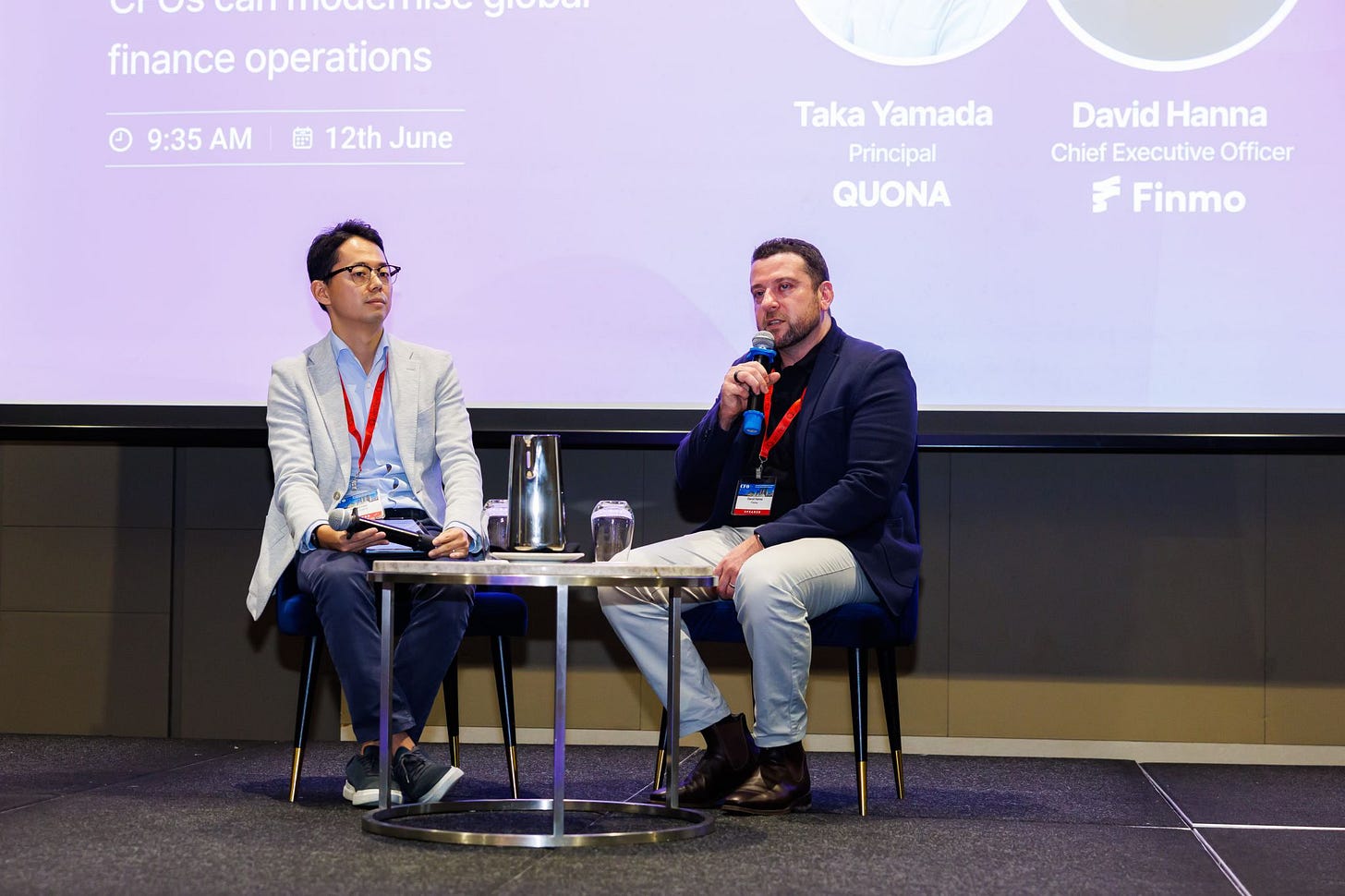Building the CFO stack for global finance teams
In conversation with Finmo's CEO, David Hanna. And weekend reading review.
In the days leading up to the publication of this post, news broke that Finmo has received approval from the UK regulator, the Financial Conduct Authority (FCA), to operate as an Electronic Money Institution (EMI).
Often referred to as an E-Money licence, becoming an EMI will give Finmo the ability to issue accounts, offer domestic and international transfers, and integrate directly with clearing systems such as Faster Payments.
After the interview you’ll find a selection of weekend reading links.
If you missed last week’s look at augmented reality (AR) payments, then make sure to check it out via the link below.
The multi-bank reality
It's common for UK start-ups to have not just one bank account, but often at least two. Usually, this consists of an account with a traditional bank such as Barclays, Lloyds, or HSBC, and then another account with a neobank such as Revolut or Wise.
With traditional banks, companies can benefit from credit facilities, business loans and a named relationship manager. The business banking offerings from neobanks tend to lack the personal touch, but they offer better Foreign Exchange (FX) rates, integrated virtual cards, and other tech-first options.
This approach isn’t too dissimilar to the approach that many consumers take with their finances. Even the most hardcore Revolut fan, who pays £650 a year for their Ultra account, will need another account with a legacy bank, at least for their mortgage.
By the way, the term legacy bank isn’t meant negatively. These banks have a long history and represent stability. Neobanks don’t have physical branches, which can seem strange to some people, and legacy banks are still more trusted to handle large deposits.
Just like consumers, companies want the best of both worlds.
Companies want the best CFO stack possible. But wherever you look, there’s complexity that needs to be managed. This is only accentuated with global companies.
For global companies, complexity is more than managing two or three bank accounts.
These organisations have to deal with accounts payables and receivables, in multiple currencies from various countries. Quickly, complexity can mount, and that’s before you get into invoicing requirements, integrations into accounting software such as QuickBooks, and any other platforms that a business might use.
Finmo was founded to help organisations manage this complexity.

Building the Treasury Operating System
Historically, CFOs have been asking their finance controllers to print off balances each day from various accounts, enter figures into Excel, and consolidate data manually. Yet in 2025, there must be a better way to do things. I spoke to David Hanna, CEO of Finmo, to find out more.
Finmo describes itself as a next-generation Treasury Operating System. What does this mean in practice?
Treasury is one of the most fragmented areas in finance. At month end, or even day-to-day, it’s not unusual to see 20+ Excel tabs open, as well as various other applications. Teams need to move between bank portals and other systems as seamlessly as possible, but this has largely been done manually up until now.
Finmo represents a step change in how companies can run their Treasury operations. I’ve seen CFOs and Treasurers pull their hair out - if there’s an important event on the horizon, such as a board meeting, or a strategic review, it can be so hard to bring everything together.
At Finmo, we want to make the CFO’s life easier by bringing everything together, and this is what we mean when we talk about a Treasury Operating System. Minimising the day-to-day effort needed, optimising processes, and improving the data for global finance teams, in a way which is compliant and meets the high standards of global organisations.
We’ve built four core modules that address the most critical needs of modern treasury teams: Cash Visibility; Money Movement; FX Risk Management; Unified Integrations. Together, these modules give CFOs and their teams the control, speed, and insights they need to move from reactive tasks to strategic decision-making
You talk about moving from reactive to strategic - can you give me a real example of what reactive treasury management actually looks like?
I was once talking to a mid-sized FMCG company that was operating across seven markets in Asia. Their treasury set-up included 14 different bank relationships, each with their own portals, approval workflows, and reporting formats. They had one person solely dedicated to logging into each system every morning, pulling balance reports, and manually updating a master Excel sheet before 10 AM each day.
It wasn’t just inefficient, it was risky. If that person was out sick or made a mistake, the CFO had zero visibility. It made me aware that treasury complexity wasn’t just an issue for large enterprises, but companies of all sizes.
How does Finmo replace Excel workflows and enable real-time decision-making?
Finmo connects directly to banks, either through direct integrations or via open banking partners to pull live balances and transaction data into a single dashboard. This eliminates the need for manual downloads and Excel consolidation. CFOs get real-time visibility across accounts, currencies, and entities, so they can make faster, more informed decisions without jumping between bank portals.

Leadership and launching in Asia first
Your background has been in senior leadership roles, mainly in the compliance and risk domains, working in organisations such as Rapyd, PayPal, and Ernst and Young. How have you found the transition from these roles to founding and being the CEO of Finmo?
I’ve always believed that everyone has a treasury problem - even at an individual level.
Personally, I’ve always found it frustrating to keep track of my own finances across multiple bank accounts, credit cards, mortgage payments, rent - it’s fragmented and time-consuming. Scale that problem to a mid-market company operating in multiple countries with different banking systems, currencies, regulations, and you start to see just how overwhelming treasury management becomes.
Businesses today are born global. You can spin up entities, teams, and operations across markets far more easily than before, but the financial infrastructure hasn’t kept pace. You still need visibility, control, and coordination across everything: cash, payments, FX, risk. That’s why treasury is no longer a back-office function - it’s foundational. That's the insight behind Finmo. We started with payments and cross-border flows, but the bigger vision was always to solve treasury end-to-end.
Many fintechs start in the UK or US and then expand out to other regions. Starting in Asia seems more challenging, especially as there’s a lack of open banking infrastructure in these markets. What’s the thinking behind starting in Asia?
It may seem like a harder path, but our solution is well-suited to this region, so it’s actually a strategic advantage. Let’s take an example of a mid-market company, headquartered in Singapore but with financial operations in Thailand, Malaysia, the Philippines, and so on. Each country has different banking infrastructure, different regulations, and different payment rails. What Finmo does is stitch together the complexity of a complex setup.
There's no real concept of open banking like you see in Europe. Therefore we’ve taken the approach of integrating directly with banks to pull balances into one platform, giving CFOs that aggregated view they need. You can't manage FX risk or make strategic decisions if you don’t know where your money is sitting, so this integration is vital.
In any case, with open banking, you can read transaction data through APIs, but typically you can't write - you can't initiate payments or move money. We've acquired licenses across the region, which means we can be in the actual funds flow. We can move money between accounts in different markets and in real-time. Our ability to send payments and provide a wider suite of functions, on top of the dashboard functionality, is what makes Finmo a full-scale Treasury Operating platform.
AI-Powered Treasury
When we met at Money20/20 Amsterdam, you had just unveiled MO AI to significant interest. What are some of the key challenges and efficiencies that you expect MO to solve for?
We see AI as an important component of how we work with our clients. MO AI is all about enabling CFOs and their teams to work proactively to achieve better outcomes.
Think about the CFO who is settling down on a Monday morning with their coffee and looking at their aggregated account view. Mo can provide information regarding cashflow, and recommend actions to help optimise the company’s position. This could be flagging an upcoming cash crunch in a specific currency or recommending an FX hedging approach based on exposure patterns.
The key thing is that MO AI is a custom-built architecture that goes beyond traditional AI assistants. It combines real-time data integration, contextual financial understanding, and action execution via Finmo’s proprietary Model Context Protocol (MCP). The goal was not to use AI only to automate, but to create an intelligent treasury partner that can help teams enhance their workflows. Additionally, MO AI can help with more mundane tasks, such as creating invoices, but rather than clicking through pages of screens and forms, enabling actions in a conversational way.
Future plans
What do you have planned for the rest of 2025? Where are you focusing your resources?
Recently we announced that we have obtained our EMI (E-Money) license in the UK. This is exciting for us as it represents the next step of our hub-and-spoke expansion strategy, meaning that we can serve clients across multiple regions from key jurisdictions.
As part of this expansion, we will be expanding our UK-based compliance and operations teams. Additionally, we will be scaling our embedded finance solutions and deepening our partnerships with capital market providers for liquidity and FX management in the region.
Why did you choose the UK market for the EMI license?
The UK is a global financial epicentre with a mature regulatory environment, giving Finmo the credibility and infrastructure to anchor our EMI operations.
Direct participation in Faster Payments and CHAPS allows us to deliver real-time GBP clearing, settlement, and treasury flows - removing reliance on third-party intermediaries and enabling end-to-end control.
Also the UK’s time zone overlap with Asia and North America makes it the ideal hub for 24/7 treasury orchestration and payment routing across global markets.
Does this tie into a broader licensing strategy?
Absolutely, the UK EMI licence is a key spoke in Finmo’s global regulatory architecture, and complements our existing approvals in Singapore, Australia, New Zealand, Canada, the United States, and soon in Dubai and Hong Kong.
Clients can operate across jurisdictions with unified compliance and consistent infrastructure. With each regulated entity integrated into our treasury platform, clients benefit from a single source of truth for balances, flows, and FX exposure across the UK, Asia Pacific, and North America.
Thanks David for your time
Weekend Reading
Global crypto assets reach $4 trillion
The past week was deemed “crypto week” by republicans in the US House of Representatives, with two major pieces of digital asset legislation advancing through Congress. As the Financial Times' Nikou Asgari reported:
The value of the global cryptocurrency market has reached $4tn for the first time, as investors anticipate billions of Wall Street dollars flooding into the sector after the passage of landmark US digital asset legislation.
The GENIUS Act, which regulates and clarifies various aspects of stablecoins - including requirements for reserve backing and licensing - was passed by Congress on Thursday, providing the framework that stablecoin issuers have long sought.
Additionally, the Clarity Act was passed by the House of Representatives this week, but still needs to be voted on by the Senate. One of the main aspects of the Clarity Act is to provide a set of tests that determine whether a crypto asset should be regulated as a security or a commodity - a topic that has been a much-discussed regulatory grey area.
The Trump administration’s crypto assets
Meanwhile, in the Washington Post, an investigation looks at the extent to which Trump administration officials and nominees hold crypto assets:
Trump officials and nominees reported a minimum of $193 million in crypto assets, including both cryptocurrency holdings and investments in crypto or blockchain companies. The disclosure forms report holdings in ranges, rather than specific figures, so the full amount is almost certainly higher…
Trump was a skeptic of crypto in his first term, but now digital assets make up a significant share of his own portfolio. World Liberty Financial, a crypto venture that is majority-owned by his family business is one of his top sources of income, according to his disclosure form.
The softening of the regulatory environment in recent months has certainly improved the returns on crypto assets. The administration refutes any conflict of interest, instead noting the broader push for clarity as a necessary step to support innovation and provide certainty for market participants.
Crypto’s UX problem and Ziglu
The one thing I find hard to believe is that after so much time and effort, the UX in most crypto apps is still so poor. I’ve tried a wide variety of wallets and exchanges recently. Now and again I review some of the leading crypto apps to see how they are evolving, and most have become more complex over time.
The average user doesn’t want to be presented with hundreds of coins to buy, and lists of trending tokens. Most want to buy Bitcoin or other core assets in an easy to understand way. Perhaps Cash App in the US does a good job of keeping crypto purchases simple, but I can’t access this in the UK to see it myself.
Ziglu set out to offer a user friendly crypto experience in the UK. The app offered a limited range of cryptocurrencies alongside a “boost” product which took advantage of the high yield available in crypto markets. Robinhood sought to buy Ziglu in 2022, but the deal never went through - Robinhood walked away from the deal in 2023.
It always felt like the potential acquisition by Robinhood was a make or break moment for Ziglu. Despite raising money earlier this year, Ziglu entered special administration on the 7th July.
What humans do next

Moving away from crypto, the Working Theorys Substack looks at the five types of work humans will do in the coming AI future. Specifically the essay looks at what the world will be like in a so-called “gentle singularity”, an idea that Sam Altman espoused in an essay last month. This section of Altman’s essay stood out when it comes to the future of work:
The rate of technological progress will keep accelerating, and it will continue to be the case that people are capable of adapting to almost anything. There will be very hard parts like whole classes of jobs going away, but on the other hand the world will be getting so much richer so quickly that we’ll be able to seriously entertain new policy ideas we never could before. We probably won’t adopt a new social contract all at once, but when we look back in a few decades, the gradual changes will have amounted to something big.
In the Working Theorys essay, Anu Atluru goes further, and explores the various skills humans will need in the “gentle singularity”, and elucidating in a few short paragraphs what each of these skills will mean. It’s compelling reading. For instance:
We've invented superintelligence of some kind, but I'm skeptical about how fast it replaces human-centered systems. Machines become the "core" of operations, but we'll still need a "human layer" in every domain. The digital singularity arrives before the physical one, both with humans in the loop.
The question isn't whether humans will work, but what kind of work humans do in the ‘gentle singularity.’ It's not just art, and creativity isn't the only skill we'll need. Human work will live in Trades, Research, Art, Community, and Stewardship.
Lastly, another Sam Altman themed read this week is a Wall Street Journal article titled “How Sam Altman Outfoxed Elon Musk to Become Trump’s AI Buddy”, which takes us into the world of lobbying, global politics, and AI policy. Well worth a read.
Note that views expressed on this Substack are my own and do not represent any other organisation. Also nothing I say should be taken as investment advice.



